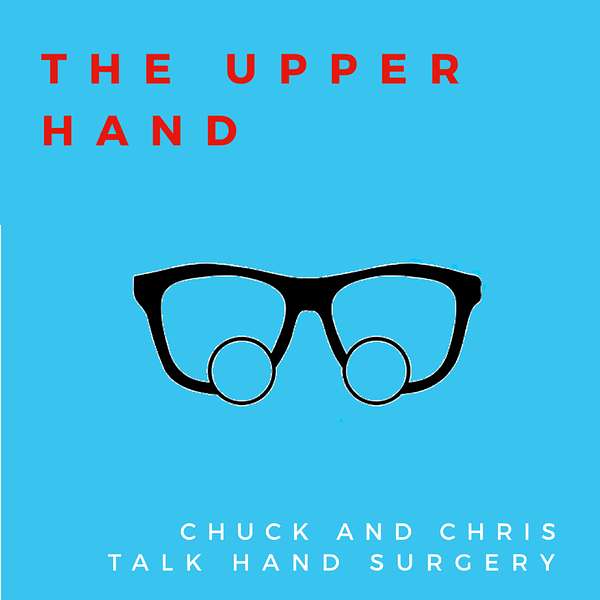
The Upper Hand: Chuck & Chris Talk Hand Surgery
The Upper Hand: Chuck & Chris Talk Hand Surgery
AIN Palsy and Advice for New Fellowship Grads
Chuck and Chris discuss fellowship graduation, a case of AIN palsy, and advice for new fellowship graduates as the establish their practices. Join us to hear our opinions and always feel free to share yours at handpocast@gmail.com
We are in need of a podcast intern! We would appreciate any referrals!
See www.practicelink.com/theupperhand for more information from our partner on job search and career opportunities.
The Upper Hand Podcast is sponsored by Checkpoint Surgical, a provider of innovative solutions for peripheral serve surgery. To learn more, visit https://checkpointsurgical.com/.
As always, thanks to @iampetermartin for the amazing introduction and concluding music.
For additional links, the catalog. Please see https://www.ortho.wustl.edu/content/Podcast-Listings/8280/The-Upper-Hand-Podcast.aspx
Social Updates and AI in Medicine
Charles and Christopher discussed their recent social activities, including a farewell dinner for outgoing fellows and Charles's upcoming 55th birthday celebration. They briefly touched on the topic of artificial intelligence in medicine, with Charles sharing his involvement in a departmental committee exploring AI applications. The conversation then shifted to the quality of Christopher's voice on their podcast, with Charles noting that his friend had complimented Christopher's audio performance. Finally, they mentioned an upcoming discussion about a medical case and tips for entering practice, which was a topic selected by one of the outgoing fellows for a conference presentation.
AIN Palsy After Regional Blocks
Christopher discussed a patient who experienced an AIN palsy after open shoulder surgery and a scalene level block, with the palsy persisting for three months before improving slightly. Charles noted that while ultrasound-guided forearm level blocks are beneficial, some patients experience residual effects like nerve palsies or CRPS, though the incidence is unclear. They agreed that in such cases, it's often difficult to determine whether the injury is related to the surgery or the block, and they should focus on providing care rather than trying to identify the exact cause.
Advancing Nerve Injury Recovery
Christopher and Charles discussed the challenges of managing nerve injuries, particularly in cases where patients desire faster recovery than the traditional "wait and see" approach allows. They explored various treatment options, including tenotomy, nerve transfer, and microsurgery, while acknowledging that even these procedures may not yield immediate results. Charles noted the declining patience among patients for long recovery periods, highlighting a broader societal trend away from delayed gratification.
Tendon Transfer Surgical Techniques
Charles and Christopher discussed the surgical techniques for tendon transfers, focusing on the use of the flexor pollicis longus (FPL) and the brachioradialis (BR) muscles. They agreed that an end-to-side repair to the FPL was a good option for patients seeking strength and some IP flexion, particularly for work-related reasons. Christopher shared his technique of using a Pulvertaft weave and checking tension with wrist tenodesis. They also briefly touched on the potential limitations of thumb motion after such procedures. The conversation concluded with a plug for an upcoming industry forum at the ASSH annual meeting, which will cover various topics in hand and nerve surgery.
Strategies for Young Surgeon Success
Christopher and Charles discussed strategies for young surgeons entering practice, focusing on time management, networking, and patient education. They agreed that early practice time should be used for research, preparation, and community engagement rather than seeing patients. Christopher shared his experience with developing patient education materials and networking with hand therapists and primary care physicians. Charles emphasized the importance of maintaining a broad general practice while building relationships with various referral sources in the community. They also discussed the challenges and benefits of different clinic scheduling models, with Charles preferring OR days over split clinic days.
Clinic Scheduling and Efficiency Discussion
Christopher and Charles discussed the scheduling and management of clinic sessions, particularly focusing on Friday afternoon clinics. They agreed that while patients appreciate the convenience of Friday afternoon appointments, support staff and doctors may not prefer this timing. They also discussed the importance of efficient time slots, with Charles suggesting a 10-minute standard duration and Christopher noting that with AI assistance, some patient interactions can be completed in under 5 minutes. The conversation concluded with a recommendation for new graduates to start with 4 patients per hour and to maintain a flexible, one-size-fits-all approach to scheduling.
Essential Qualities for Assistants
Charles emphasized the importance of hiring the right assistants, highlighting that their role is crucial as they represent the practice. He noted that while experience is valuable, he looks for assistants who are team-oriented, have good interpersonal skills, and can effectively communicate with patients. Christopher agreed, adding that the ability to troubleshoot and provide reassurance to patients, both over the phone and in person, is more important than specific clinical training backgrounds.
Building Strong Nurse Relationships
Charles and Christopher discussed the importance of building strong relationships with nurses and team members in medical practice. They emphasized the need for the right level of insight, proper compensation, and shared mission and vision to create a positive work environment. They also highlighted the importance of involving team members in decision-making and making them feel valued. The conversation concluded with a promise to address more clinical topics in future episodes and an open invitation for listeners to share their questions and experiences.